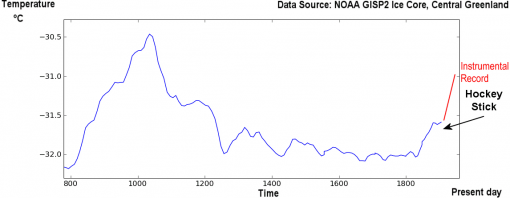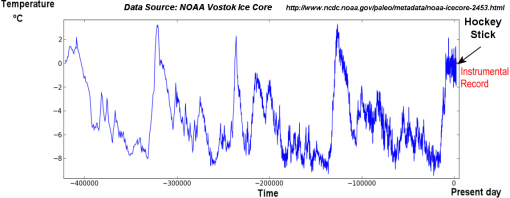
Figure 1: Temperature in Central Greenland over last 1200 years.
A continual theme expressed at Skeptical Science is one should take in the broader picture rather than focus on small pieces of the puzzle. There is a YouTube movie currently propogating through the blogosphere that purports to do this. Rather than narrowly focus on just the hockey stick of the last few thousand years, it examines temperature change in Central Greenland over the past 500,000 years. This shows that that there are periods where Greenland temperatures were warmer than today, including the Medieval Warm Period. If current temperatures are not unprecedented, how can we say global warming is not natural?

Figure 1: Temperature in Central Greenland over last 1200 years.
Now one could nitpick the analysis by pointing out that it focuses on one location in Central Greenland. Temperature at a single location inevitably show greater variation than the global average. While Greenland showed strong warmth 1000 years ago, global temperature during the Medieval Warm Period was less than today. But the broader argument is that climate change has happened naturally in the past. Global temperatures have changed dramatically - in particular during those periods when we emerged from world-wide ice ages. Looking back over the past 500,000 years, we see periods where temperature has warmed over 10°C and interglacial periods that were warmer than today.

Figure 2: Temperature in Antarctica over last 450,000 years.
Many peer reviewed papers have studied these periods to glean a deeper understanding of climate. As climate scientist Dana Royer puts it: "the geologic record contains a treasure trove of 'alternative Earths' that allow scientists to study how the various components of the Earth system respond to a range of climatic forcings." The key result we obtain from examining past records is that climate is sensitive to changes in the planet's energy balance. When the planet accumulates heat, global temperatures rise, enhanced by net positive feedbacks. In the past, energy imbalance (or radiative forcing) have been imposed by a combination of forces: changes in the Earth's orbit, solar variations, volcanic activity and yes, natural changes in greenhouse gases.
Rising carbon dioxide in the atmosphere is currently causing a heat build-up. While there are various uncertainties in climate science, the radiative forcing from carbon dioxide is one factor that is known with high understanding and confirmed by empirical observations. How much warming can we expect from rising carbon dioxide? The temperature change is determined by climate sensitivity, which is determined from past periods. By comparing temperature change in past periods to the energy imbalance over that period, we can calculate climate sensitivity.
There are important lessons to be learnt from the past 500,000 years of temperature change. But the lesson is not that humans can't change climate. On the contrary, the past provides evidence for our climate's sensitivity to carbon dioxide.
For more detail on how past climate change tells us about climate sensitivity, see "Climate's changed before". Apologies to regular readers as this post revisits existing material - the inevitable consquence when forced to respond to rehashed skeptic arguments.
Posted by John Cook on Tuesday, 15 December, 2009
 |
The Skeptical Science website by Skeptical Science is licensed under a Creative Commons Attribution 3.0 Unported License. |